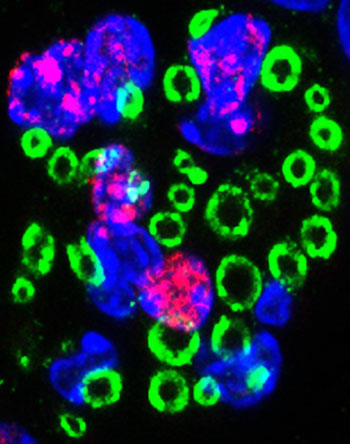Molecular Mechanism Regulating Regeneration of Spinal Nerves Identified
By LabMedica International staff writers
Posted on 29 Mar 2016
The protein neuregulin-1 was found to regulate the repair mechanism that attempts to restore lost myelin following spinal cord injury.Posted on 29 Mar 2016
Following traumatic spinal cord injury, acute demyelination of spinal axons is followed by a period of spontaneous remyelination. However, this endogenous repair response is incomplete and may account for the chronic loss of function demonstrated by surviving axons. Spontaneous remyelination is largely mediated by Schwann cells, where demyelinated central axons, particularly in the dorsal columns, become associated with peripheral myelin. The molecular control mechanism, functional role, and origin of these central remyelinating Schwann cells are currently unknown.

Image: A confocal micrograph of the lesion core following spinal cord injury. Nuclear EdU (red) shows the presence of newly differentiated cells which produce Schwann cell myelin (green). These peripheral-like Schwann cells remyelinate central axons in the injured spinal cord and are important for spontaneous repair and functional recovery after spinal cord injury (Photo courtesy of King\'s College London).
The growth factor neuregulin-1 (Nrg1, encoded by the NRG1 gene) is a key signaling factor controlling myelination in the peripheral nervous system, via signaling through ErbB tyrosine kinase receptors. The neuregulins are a family of four structurally related proteins that are part of the EGF (epidermal growth factor) family of proteins, which have been shown to have diverse functions in the development of the nervous system.
Investigators at King's College London (United Kingdom) and the University of Oxford (United Kingdom) examined whether Nrg1 was required for Schwann cell-mediated remyelination of central dorsal column axons and whether removal of Nrg1 would influence the degree of spontaneous remyelination and functional recovery following spinal cord injury.
They reported in the March 17, 2016, online edition of the journal Brain that Nrg1 signaling mediated an endogenous regenerative event in which Schwann cells remyelinated denuded central axons after traumatic spinal cord injury and that Nrg1 was an important mediator of spontaneous functional repair after spinal cord injury. In mice lacking the NRG1 gene, spontaneous myelin repair was completely prevented and spinal nerve fibers remained demyelinated. Furthermore, mice without NRG1 showed worse outcomes after spinal cord injury compared to mice with the gene intact, particularly in walking, balance, and coordinated movements.
Senior author Dr. Elizabeth Bradbury, professor of regenerative medicine and neuroplasticity at King's College London, said, "Spinal cord injury could happen to anyone, at any time. In an instant your life could change and you could lose all feeling and function below the level of the injury. Existing treatments are largely ineffective, so there is a pressing need for new regenerative therapies to repair tissue damage and restore function after spinal cord injury."
"These new findings advance our understanding of the molecular mechanisms which may orchestrate the body's remarkable capacity for natural repair," said Dr. Bradbury.
"By enhancing this spontaneous response, we may be able to significantly improve spinal cord function after injury. Our research also has wider implications for other disorders of the central nervous system which share this demyelinating pathology, such as multiple sclerosis."
Related Links:
King's College London
University of Oxford














